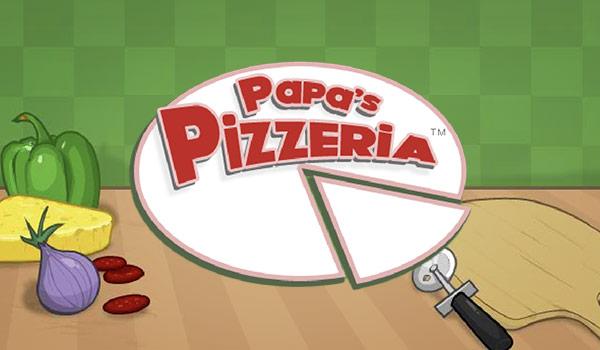Sharing the theme of cooking and gathering ingredients to satisfy customer needs, Papa’s Pizzeria contrasts with our game mainly in mechanics of player, objective, and outcome, creating a dynamic centered around multitasking and time management, appealing chiefly to the aesthetics of challenge.
Papa’s Pizzeria is an online video game of running a pizzeria. It is published by Flipline Studios with target audience being individual players from almost all age groups (rated 4+ on the app store), available online and on multiple mobile platforms (Android and iOS). I played it online on a MacBook.
Papa’s Pizzeria is similar to our game in terms of premise and outcomes, creating a shared aesthetic of challenge. We are designing a cooking game where every player tries to gather ingredients (presented as ingredient cards) to cook a dish that satisfies the judge’s demand (the judge card). Similarly, Papa’s Pizzeria operates with customers consistently coming into the store and making demands. The player’s objective is to cook a pizza that best fits each customer’s demand, using the right ingredients, baking time, and cutting style(fig.1). The more fitting the pizza is to the customer’s need, the more tips the player receives as a reward. As the player’s level increases, the customers’ demands for each pizza become more complex, and the tips also become larger. Over time, this builds a dynamic of completing higher challenges and receiving better rewards (fig.2). In our game, each user needs to gather ingredients for a dish by drawing new ingredient cards or exchanging ingredients with other users. As the complexity of some recipes increases, the difficulty of gathering those ingredients also increases. Thus, the two games share the component of gathering ingredients and satisfying customers’/judges’ needs, creating the fun of the challenge in completing tasks despite difficulties.

fig1. Required ingredients, time, cutting style

fig.2 Reward system with ranks and tips
However, Papa’s Pizzeria diverges from our game in terms of player, objective, and outcome, centering the challenge in aesthetics, while our game aims to emphasize both challenge and fellowship. Papa’s Pizzeria features an individual player versus game mechanic, and the sole objective is to gain more tips and advance to higher levels. It is a non-zero-sum game, where over time, players simply become better at managing the game flow and time, thus earning more tips. For example, when I first started the game, I was too scared to make multiple pizzas at the same time, fearing that I would mess up the timing for each pizza as I switched to other tasks such as greeting new customers or completing orders. However, as I gained more experience over time, I naturally developed a sense of time. With a simple glance at the clock symbol on the order, I knew approximately how many other tasks I could complete during the duration when this pizza was being baked. I even developed a sense of rhythm through the game’s background music and was able to keep track of time by counting beats, which naturally corresponded to the clock next to the oven (fig.3) in my head. However, the game we are designing aims to foster player versus player, multilateral competition. Each player tries to satisfy the judge’s demand while preventing others from doing so. With rules such as trading or stealing ingredients, each player aims to outwit other players in the zero-sum game and be the first one to complete the dish demanded by the judge to win. Our game mechanics would encourage people to gain trust from or deceive other players, creating a dynamic of constantly changing social frameworks, adding to the aesthetics of fellowship. The key difference here is that the challenge of gathering ingredients comes from the computer (with increasingly demanding requests) in Papa’s Pizzeria, while in our game, it arises from players’ interactions (trying to satisfy judges’ needs without letting others know).

fig.3 Clocks next to oven
(players depend less on them with more experience)
As the levels increase, Papa’s Pizzeria could become boring as players become familiar with procedures. Once the player no longer relies on the in-game clock to track time, challenges become less demanding. Moreover, there is only one spot for making and cutting pizza (no way to make two pizzas side by side!), limiting the potential for multitasking. Compared to other games in this genre, Papa’s Pizzeria has very limited flexibility in the pizza creation process, which restricts players’ fun of expression. We could enhance flexibility by adding more spots for making and cutting, as well as introducing more ways to incorporate interesting ingredients into the pizza.
In conclusion, Papa’s Pizzeria excels in cultivating the fun of challenge through increasing difficulty of customers’ demand, similar to our own game. However, the absence of multi-player competitions diminished the potential for fostering fellowship, a crucial element central to our game aesthetics.




